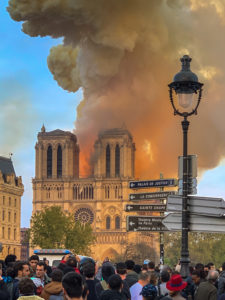
The Notre Dame fire in Paris, April 15, 2019 by Milliped CC BY-SA 4.0 on Wikipedia
In the year 1163, the first stone of the Notre Dame de Paris cathedral was placed with Pope Alexander III in attendance. The cathedral, which houses the crown of thorns relic, sits on the Île de la Cité, an island in the center of the Seine River within the Paris Basin. The construction of Notre Dame took almost two centuries to thoroughly complete, with the 12th-century Bishop of Paris, Maurice de Sully, being the man who initially proposed its construction. Sully contracted an architect (whose identity is unknown) to plan the new church in 1160.
In 1182, under the rule of the new king, Philip II, the high altar was consecrated. Sully was able to celebrate the first Mass in the cathedral but would die in 1196, 150 years before the main structures of the cathedral would be finished in the 1300s.
While all of those who designed and aided in the construction of the cathedral would not live long enough to witness this cathedral dedicated to the Virgin Mary, the cathedral came to withstand 900 years of human progress and revolution. As of last Monday, however, the world witnessed this beautiful monument burst into flames. The cathedral was undergoing renovations at the time of the fire, which devastated large parts of the 850-year-old building before it was finally extinguished after a nine-hour battle.
For people of the Catholic faith, Parisians, and those who appreciate the aesthetic and cultural significance of Notre Dame, this disaster struck deeply passionate chords. Millions have expressed sympathy and a willingness to help rebuild to the extent that they’re able. Though not all retained empathy for the cathedral’s accident. Some individuals have been outspoken about their feelings, more specifically addressing the millions of dollars flowing into funds to help reconstruct what was lost. Some claim that the cathedral is not as important a venture to pour large amounts of private money into when the world faces more challenging humanitarian crisis.
More radical comments have even gone so far as to suggest that the Notre Dame cathedral represents the history of oppression wrought throughout the centuries in western civilization and as such it should not be mourned. Critics include some of those presently publicly demonstrating on the streets of Paris against current tax policy and themselves, setting fires.
Whatever the view, these questions are important in consideration of our own feelings about the significance of the event, if any are to be held at all. There may be some merit, then, in making a collective effort to at least maintain respect for the cathedral’s objective history rather than its cultural, spiritual and architectural impacts. When we know a symbol’s true history, we can begin to understand its true meaning more thoroughly. The initial intent of its creators would provide us with the details necessary to complete this understanding. And since we are left without the original advocate in Maurice de Sully and his mystery Architect to comment personally, we have only the objective history of the Notre Dame de Paris cathedral and what remains.
What will be reconstructed will bear the new history of the fire on Aril 15th, 2019 and the world’s various reactions. The world is now a part of the cathedral’s story in a beautiful way and as a chapter in the history of Notre Dame ends, a new chapter begins.
LMA Newsletter of 4-22-19


